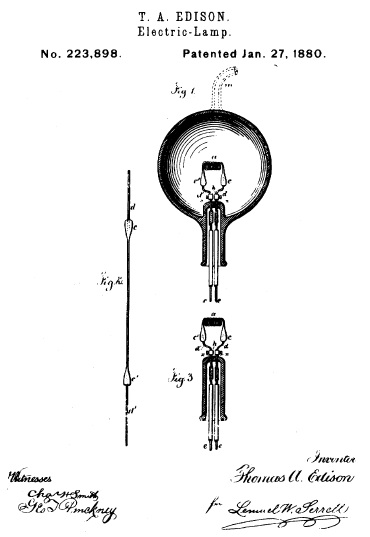Edison’s Lightbulb Dims as Freedom Flickers – by Deroy Murdock
 NEW YORK — As the United States of America celebrates its 234th birthday, the plight of a quintessentially American innovation says volumes about the state of the union.
NEW YORK — As the United States of America celebrates its 234th birthday, the plight of a quintessentially American innovation says volumes about the state of the union.
As American as the grand slam, the Mustang convertible, and the constitutional republic, Thomas Alva Edison’s incandescent light bulb is among this nation’s most enduring gifts to mankind. Granted U.S. Patent No. 223,898 on January 27, 1880 (after enduring some 1,200 experiments), Edison’s “Electric Lamp” essentially made night optional for most Earthlings. Days stopped ending at sunset. Simple, convenient, and cheap, Edison’s greatest invention also was far safer than the flammable kerosene lamps they replaced.
Today’s federal government, naturally, had to hammer something that has hummed along nicely for 130 years. In one of his most shameful acts, former President George W. Bush stupidly signed the Energy Independence and Security Act of 2007. EISA establishes performance criteria that Edisonian bulbs cannot meet. As the Federal Trade Commission (FTC) explains: “These standards, which begin in 2012, will eliminate low efficiency incandescent light bulbs from the market.”
According to an April 14 fact sheet from General Electric, which Edison founded in 1876, 276 of its incandescent bulbs will start to vanish just 18 months from now. Few Americans realize that federal busybodies plan to snatch their traditional bulbs. Sylvania’s December 2009 survey of 302 adults found that “awareness of the 2012 100-watt bulb phase-out is” just 18 percent. (Error margin: +/- 5.7 percent)
EISA has made more common the Compact Fluorescent Lights, those swirly bulbs with distinct pros and cons. Costlier up front, energy-efficient CFLs eventually save money. They also require less frequent replacement than do traditional bulbs.
To discover CFLs’ negatives, try setting a romantic mood with a dimmer switch. This is, at best, a hit or miss proposition.
Scarier still, just drop one onto your kitchen floor. Its internal mercury is highly toxic. If spilled, it requires something approximating a Superfund cleanup. The Environmental Protection Agency warns that if a CFL breaks on one’s apparel or bedspread, “Do not wash such clothing or bedding because mercury fragments in the clothing may contaminate the machine and/or pollute sewage.” (Emphasis added.)
CFLs should be discarded at recycling centers. Hundreds of millions of busy Americans, however, will toss these dangerous bulbs in the trash, atop table scraps and junk mail. CFLs will clog landfills from coast to coast. Decades hence, mercury will have leeched into the environment. Americans will wonder why people are suffering brain, kidney, and lung damage. Medical visits will yield lawsuits. And another national disaster will erupt, courtesy of Washington, D.C.
Team Obama characteristically has inherited a big-government jalopy from the Bush-Rove Administration and then turbocharged it.
As June 25′s Washington Times detailed, 91 pages of brand-new FTC rules force manufacturers to label the front of CFL packages regarding brightness (in lumens) and annual energy cost (in dollars). Packages’ sides or rears must disclose bulbs’ lifespan, color appearance, wattage, voltage, and mercury content.
“I think the incandescent light bulb was one of the great contributions to the art of architecture in the 20th Century,” says Howard M. Brandston, a legendary lighting designer renowned for relighting the Statute of Liberty before its rededication on July 4, 1986. “Lighting played a huge role, as essential as the structures themselves. That was thanks to Thomas Edison.”
“Our homes are our castles,” says Brandston, a former adjunct professor of architecture at Rensselaer Polytechnic Institute. “The government should not enter our homes, tell us how to live, endanger our health, and ruin our quality of life.”
Republicans and thinking Democrats running for Congress this fall should pledge publicly to repeal the federal ban on Thomas Edison’s monumental creation. Why not try something worthy of the Spirit of ’76? Keep traditional bulbs, CFLs, halogens, and everything else on the market, and allow Americans to purchase whatever bulbs help them pursue happiness.
July 4 would be a perfect day for such a Declaration of Incandescence.
* Deroy Murdock is a columnist with Scripps Howard News Service and a media fellow with the Hoover Institution on War, Revolution and Peace at Stanford University.
No comments:
Post a Comment